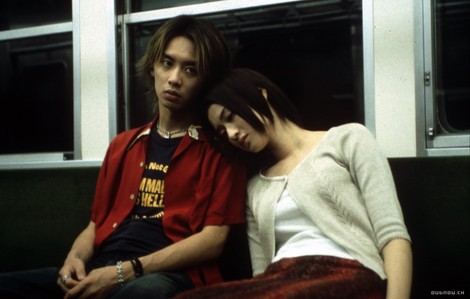December 11, 2005
pulse

On Kiyoshi Kurosawa’s Pulse (Kairo), recently playing at the IFC Center: though spurred on by the “don’t miss it” reviews in the NYC press, we almost didn’t see this movie. IFC’s small upstairs waiting area (which had a great collection of original Truffault movie posters on display, including a very cool Japanese poster for Jules et Jim) contains a cutaway window into one of the theaters, and through it we caught a glimpse of Zizek discursing from his bed on the large screen. It looked fascinating, and as we settled into the much smaller theater Pulse was playing in with about ten other people, we were already beginning to squirm. Just how creepy would this movie be? If I’d realized it was by the director of Cure, which I loved but which disturbed me to no end, I might have bolted then, especially after an amazing trailer for Zizek, which made us look at our watches and confer whether we should go see it instead a half hour later. We’re only in New York every once in a while, we reasoned, and neither movie would likely make it to DC.
So under the premise that we’d likely seek out Zizek on DVD, we’d be getting out even later, etc., we decided to give the movie fifteen minutes. Needless to say, we stayed the entire time. The movie’s sometimes slow, nearly always beautiful, and contains the most terrifying depictions of ghosts I’ve ever seen on film. There’s also one great bit of running humor, for us at least: Ryosuke’s collection of vintage U.S. t-shirts, with a new and funnier one in nearly every scene. After a few intial set pieces that are pretty squirm-inducing, there is this one scene — several minutes of pure terror — that made me want to crawl out of my skin. Afterwards, I had to laugh quietly for a few minutes in sheer relief the scene had ended. Immediately after, two guys in front shouldered their backpacks and hurried out; this would happen a couple more times in the movie, until there were only about six people left for the ending (this was a late, Tuesday night showing the week of Thanksgiving).
Partly, it’s the music. Fantastically tense, very loud, and some of the best use of strings since Hitchcock, although very different in sound, as fitting the subject matter.
But it’s the central idea of the movie which gets under your skin. Besides the way they look and move, why are these ghosts ultimately so terrifying, and lethal to those who come into contact with them? Without answering the question, I’ll just contend with those who have said the movie makes no logical sense; while there are some dreamlike inconsistencies in the appearances and effects of the supernatural on the living in the movie, everything that happens does stand up under at least symbolic scrutiny, if you think about a few pivotal scenes where the characters discuss what they believe is going on. Ultimately, it’s a simple human emotion that’s under examination in this movie, and in the world Kurosawa creates, it’s a more unsettling thing to come face to face with than any ghost.
[Adding to the Netflix list now: Bright Future.]


